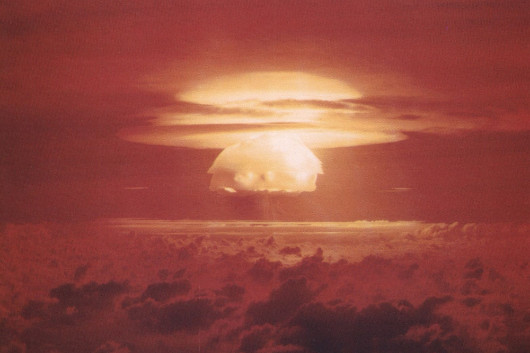Our Abyss
“LOOKING INTO THE ABYSS” is virtually (typographically) shouted from the cover of the current The American Scholar
By Martin E. MartyJune 12, 2017
 “LOOKING INTO THE ABYSS” is virtually (typographically) shouted from the cover of the current The American Scholar. It’s a teaser: the “abyss” could refer to Washington or the United States or global terrorism or… It could evoke Robert Frost’s feared choice between the world’s ending in abysses of Fire or Ice. That world, and our human race, could indeed end in an abyss that is either “wet” or “dry,” depending on how this generation and those who follow deal with climate change. But the cover story here is “Our Nuclear Future” by Jeffrey Lewis. Nothing about it pertains explicitly to Sightings’s defined topic: religion as it bears upon, or is affected by, public affairs. Yet the end of Lewis’s article—quoted at the bottom of this column—introduces the topic of changing ourselves, which is central to the mission of most faiths.
“LOOKING INTO THE ABYSS” is virtually (typographically) shouted from the cover of the current The American Scholar. It’s a teaser: the “abyss” could refer to Washington or the United States or global terrorism or… It could evoke Robert Frost’s feared choice between the world’s ending in abysses of Fire or Ice. That world, and our human race, could indeed end in an abyss that is either “wet” or “dry,” depending on how this generation and those who follow deal with climate change. But the cover story here is “Our Nuclear Future” by Jeffrey Lewis. Nothing about it pertains explicitly to Sightings’s defined topic: religion as it bears upon, or is affected by, public affairs. Yet the end of Lewis’s article—quoted at the bottom of this column—introduces the topic of changing ourselves, which is central to the mission of most faiths.
The essay is subheaded “We may think the bomb is back, but it never really went away”—an ominous line which the author fleshes out with history and data. His hook: “This summer, for the first time, there will be a negotiation under the United Nations on the convention banning the production, possession, and use of nuclear weapons.” But Russia, the U.S., and some other nations may boycott the talks. The U.S., Lewis noted as of the time of his writing, “is committed to replacing its entire triad of nuclear-armed missiles, submarines, and bombers at a cost that may exceed a trillion dollars over 30 years” Oh. In North Korea and elsewhere, the choice to explode nuclear weapons rests in the hands of a single individual. The abyss awaits?
Many religious leaders, groups, institutions, and forces-for-good observe all this, and often speak out, but can usually produce only barely noticed whispers of criticism. Lewis warns that, meanwhile, we are confronted by weapons that offer us the ability to destroy ourselves, a shared hazard for which our social mechanisms for managing large-scale violence are dangerously ill suited. Technology advances weaponry, and “is certain to disrupt nuclear deterrence. The only question is whether that means the end of nuclear weapons or the end of us.” The U.S., if threatened, would have only two to four minutes to determine whether our leaders are facing a false alarm or the End of All Alarms. Oops? Lewis reminds his readers of a National Security Agency instrument that once discovered suspicious electronic emissions coming from a sensitive facility; the culprit turned out to be a soda machine, communicating to its vendor over the internet that it needed to be restocked. Such is the way of “the internet of things.”
All of the earlier reckonings pale in comparison, writes Lewis, “to the uncertainty generated by the emerging possibility of disarming cyberattacks that could take down command-and-control nodes.” He rules out the possibility that deterrence associated with technology will solve the problem. What else? I will close simply by quoting Lewis’s last paragraph, hoping that many will look up and read the full article leading up to it. Here, though, is where I think the role of religion and spirituality comes in, as he speaks of our need to change ourselves. Thus I quote:
The solution requires, above all, understanding that our fundamental problems are political—and that we are running out of time to change our institutions and our behavior. We can choose to adapt to new technology and devise other arrangements for our security, or we can simply wait, passively accepting our fate like so many societies throughout history that hoped they would survive the rapid technology changes around them—but did not. Technological solutions are a dangerous fantasy, a convenient excuse for our lack of will to take steps in line with the dangers we face. In the end, advances in technology won’t save us; only advances in ourselves can do that [emphasis mine].
Resources
- Frost, Robert. “Fire and Ice.” Poetry Foundation.
- Lewis, Jeffrey. “Our Nuclear Future.” The American Scholar. June 5, 2017.
Image: Thermonuclear weapon test "Castle Bravo" (March 1, 1954) | U.S. Department of Energy
 Author, Martin E. Marty, is the Fairfax M. Cone Distinguished Service Professor Emeritus of the History of Modern Christianity at the University of Chicago Divinity School. Author, Martin E. Marty, is the Fairfax M. Cone Distinguished Service Professor Emeritus of the History of Modern Christianity at the University of Chicago Divinity School. |
Sightings is edited by Brett Colasacco, a PhD candidate in Religion, Literature, and Visual Culture at the University of Chicago Divinity School. Subscribe here to receive Sightings in your inbox twice a week.


